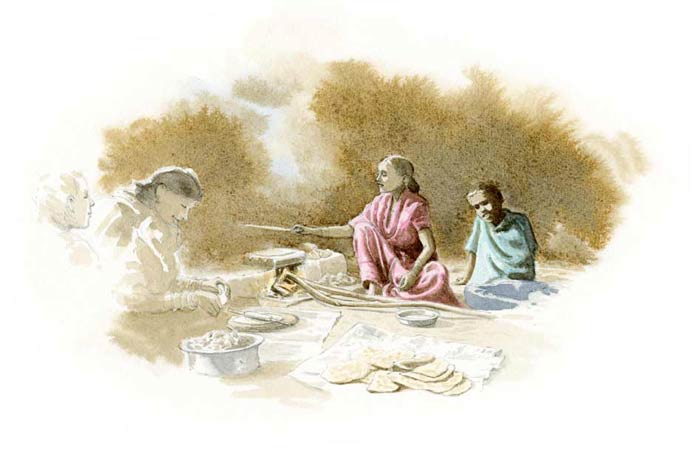chapati or roti

Form: Flat bread that blows up when cooked
Country of origin: India
What distinguishes it from other methods of bread making: Griddlecake made without any fermenting agent
Category of bread: (2) Undoubtedly, the simplest and most ancient recipe in the history of bread making. There are innumerable versions of it in the Middle East and Central Asia
Particularity: This bread is eaten with all Indian meals
Ingredients: Wheat flour; warm water; ghee (clarified butter) to grease the metal cooking plate

India
One could feasibly sum up the subsistence, the survival, the art of dining, the entire lifestyle of India through this simple, unleavened wheat griddlecake called roti (which also means “meal”) or chapati, depending on where you are in India. It’s the most readily available bread. It requires no special preparation, waiting time, frustration. A little while before the meal, small balls of dough are torn off from the dough mass, always made in the morning. The balls are roughly flattened out in the palm of the hand, and laid onto a hot plate or a cooking dish held at the level of the fire. This extremely high heat allows the chapati to puff up quickly, in just a few minutes. Once dilated (in India, it is referred to as “flowered”), the griddlecake finishes cooking directly on or near the embers, where it takes on a slight golden but not burnt color.
Even though chapati is the bread that always fills the gap when there is no other choice, it nevertheless requires great care. The dough must be thick enough to guarantee total elasticity, since the chapati is held between the fingers and used to pick up food and sop up sauce, as well as being filled with different ingredients. This griddlecake is prepared in a myriad of ways, depending on the cultural context and the grains used. In Rajasthan, for example, in the past, warriors buried balls of dough in the hot sand, left to the good grace of the desert.
Borders should make it possible to distinguish the four major representatives of bread making (naan, chapati, paratha and puri), but in India these boundaries are infinitely permeable. If you add a little oil or ghee to the dough when you roll it out, fold it in four rather like for puff pastry, the end result when you put it on the greased hot plate is not far from being a paratha instead of the anticipated chapati.

